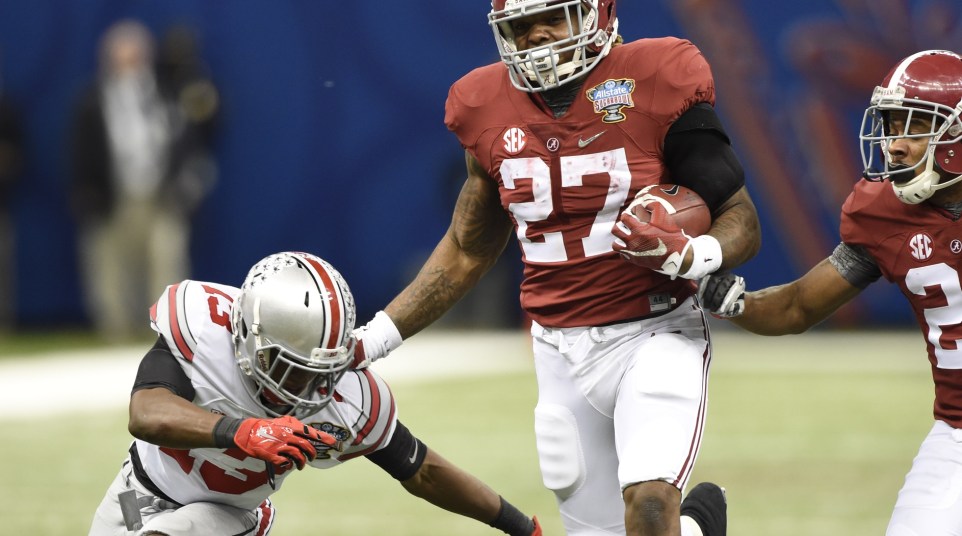
Run Tide Run? Looking at Alabama's run-pass balance in 2015
What do you think of when you look back on Alabama’s offense in 2014? Surely, your memories are of a pass-happy bunch, highlighted by all-word receiver Amari Cooper and his quarterback, Blake Sims.
You’re not wrong. In Lane Kiffin’s first year with the Tide, he sped up the offense, running a similar number of plays per game to the spread, no-huddle teams around the conference and the country. The Crimson Tide had the most prolific passing season in school history, led by first-year starter Sims.
Without looking, would you know that Alabama actually ran the ball nearly 56 percent of the time in 2014? It didn’t feel that way, not with Cooper’s 124 catches, or the way Alabama frittered away the Sugar Bowl by turning away from Derrick Henry and the run game, or with Nick Saban’s cries to run the dang ball.
Alabama’s run-pass ratio last year was in line with 2013, when the Tide ran the ball 55 percent of the time, but in three of the five years prior to that Alabama ran the ball 62 percent of the time or more. The chances of the Tide returning to that formula are slim with Kiffin calling the shots; despite some indecision at quarterback, Alabama will still throw the ball plenty, likely around 45 percent of the time again.
The Alabama offense is going to keep it’s tempo, though. Last year, the team transitioned to what you could describe as a pro-style, up-tempo team. The Tide ran 1,018 plays last year, 72.7 per game. That’s on par with Auburn (72.2), Texas A&M (71.9), slightly behind Mississippi State (77) and more than Ole Miss (69.5). On a national scale, Oregon — the team everyone thinks of when you talk hurry-up offenses — ran 74.5 plays per game in 2014. It’s a number that lags behind rapid-fire teams Baylor (87.5) and TCU (79.8), but that’s probably more than okay with Saban.
We wrote earlier this week that Alabama’s pass distribution will be a lot more even than it was in 2014, when Cooper was the target of more than 35 percent of the Tide’s pass attempts. The duo of ArDarius Stewart and Robert Foster will likely both see a big percentage of looks from whoever the quarterback winds up being — Jacob Coker, David Cornwell or someone else — with several other pass catchers in the mix.
With that quarterback situation, Alabama might not have much choice but to lean on the run in certain situations. With Kiffin’s history — including last year — it would be unwise to think that he can’t turn Alabama’s new starter into a standout, but Henry is a more trustworthy option. The entire passing game is going to be raw, though, and it could take some time to get some polish on it.
As a junior, Henry is reading to rampage through the conference. After an uneven freshman year, he ended up leading Alabama in rushing as a sophomore as T.J. Yeldon dealt with injury, and he was dominant in the Sugar Bowl until he stopped getting the ball. While Henry has some talented backups like Kenyan Drake (who figures to heavily play into the passing game) and freshmen Damien Harris and DeSherrius Flowers, he’s the unquestioned lead ball carrier and could be in line for 250 carries this year. The others will get their work, but it’ll be after Henry has had his fill.
Gone are the days when Alabama was a ground-and-pound team. The number of teams who play that slow style are dwindling. Alabama is still capable of running the ball and doing it well, as evidenced by the team’s 5.1 yards per carry last year. The offensive line, which will be rebuilt from last year, should have the nastiness to complement Henry’s power while also playing a style suited for the faster pace Alabama has adapted.
The Crimson Tide should once again have balance in 2015 while maintaining the tempo they picked up under Kiffin in year one, something it would’t be a surprise to see them build on.
